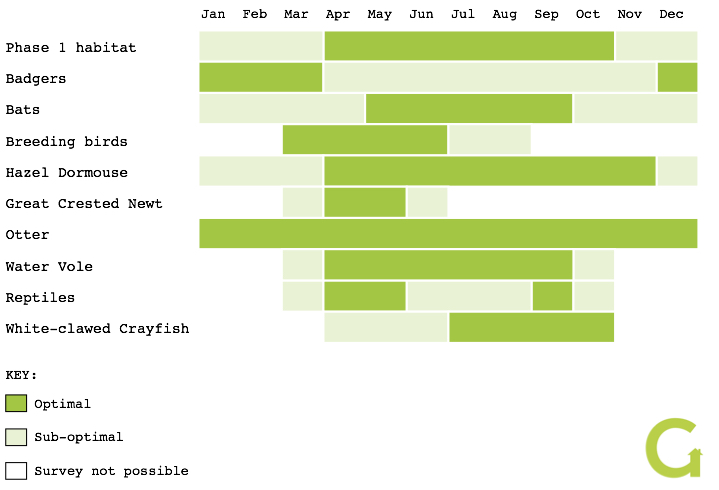SERVICES
Ecological survey and assessment is often seasonally constrained and it is essential that any planning application is informed by timely and robust surveys which have been undertaken using recognised techniques and in accordance with adopted guidance.
As a guide please refer to our survey calendar below which highlights the essential survey windows for various protected/notable species/groups.

- Desk studies
- Extended phase 1 habitat surveys
- Ecological impact assessment
Undertaking a walkover survey can be an effective technique in swiftly identifying obvious ecological constraints for the outset of a project. Often it is more cost-effective to undertake a phase 1 habitat survey to identify the ecological value of a development site and establish whether any further survey work (in relation to protected species for example) may be required. This can then define constraints which may inform project design and thereby support a robust planning application. Most local planning authorities require this level of survey (phase 1 habitat) to accompany planning applications.
Performing some form of ecological impact assessment is normally required to accompany a planning application. We provide all types of assessment, whether the project is small or large-scale where a more rigorous level of assessment may be required under the Environmental Impact Assessment Regulations 2017 or The Conservation of Habitats and Species Regulations 2017. Our ecological impact assessment is undertaken in line with the latest guidelines produced by the Chartered Institute of Ecology and Environmental Management (CIEEM).
- Protected/notable plants
- National Vegetation Classification
- Hedgerow surveys
- Aquatic surveys
- Habitat management plans
Whilst the majority of our important habitats and their species are located within designated areas subject to legal protection, such as Special Protection Areas (SPAs) or Sites of Special Scientific Interest (SSSIs), habitats protected by law and policy can be present within development sites. Local planning authorities may require dedicated survey of certain habitats present within such development sites to identify their nature conservation value.
Appropriate and timely habitat and vegetation surveys are the foundation of a sound ecological assessment and we can provide the full range of habitat and vegetation surveys across all habitats.
- Bats
- Great Crested Newts
- Hazel Dormice
- Reptiles
- Badgers
- Water Voles
- Otters
- Birds
- Invasive species
Undertaking surveys for protected species at the planning stage is now common practice as they are a matter of material consideration and cannot be deferred until after determination of a planning application.
We provide all forms of surveys for protected species and use these to quantify impacts and identify any appropriate mitigation which may be required.
Some surveys are seasonally constrained and need to be undertaken in line with adopted guidelines and best practice.
Where protected species are concerned, comprehensive mitigation strategies can be formulated in line with development (protected species) licensing requirements.
Specific impact assessment (referred to as appropriate assessment) is required should an initial screening assessment identify the potential for significant impacts on these designated sites.
We can perform this special level of assessment and identify whether any specific measures are required to enable determination of the planning application.
